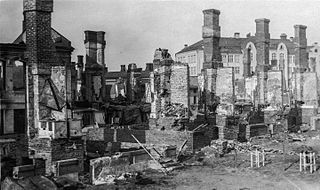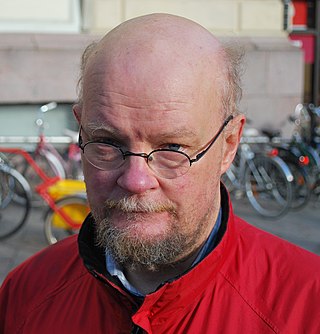
The Finnish Civil War was a civil war in Finland in 1918 fought for the leadership and control of the country between White Finland and the Finnish Socialist Workers' Republic during the country's transition from a grand duchy of the Russian Empire to an independent state. The clashes took place in the context of the national, political, and social turmoil caused by World War I in Europe. The war was fought between the Red Guards, led by a section of the Social Democratic Party, and the White Guards, conducted by the senate and those who opposed socialism with assistance late in the war by the German Imperial Army at the request of the Finnish civil government. The paramilitary Red Guards, which were composed of industrial and agrarian workers, controlled the cities and industrial centers of southern Finland. The paramilitary White Guards, which consisted of land owners and those in the middle and upper classes, controlled rural central and northern Finland, and were led by General C. G. E. Mannerheim.

Kaarlo Juho Ståhlberg was a Finnish jurist and academic, which was one of the most important pioneers of republicanism in the country. He was the first president of Finland (1919–1925) and a liberal nationalist.

Erik "Eero" Nikolai Järnefelt was a Finnish painter and art professor. He is best known for his portraits and landscapes of the area around Koli National Park. He was a medal winner at the Paris Exposition Universelle of 1889 and 1900, and he taught art at the University of Helsinki and was chairman of the Finnish Academy of Fine Arts.

The University of Helsinki is a public research university located in Helsinki, Finland, since 1829, but founded in the city of Turku in 1640 as the Royal Academy of Åbo, at that time part of the Swedish Empire. It is the oldest and largest university in Finland with the widest range of disciplines available. In 2020, around 31,600 students were enrolled in the degree programs of the university spread across 11 faculties and 11 research institutes.

Gottlieb Eliel Saarinen was a Finnish-American architect known for his work with art nouveau buildings in the early years of the 20th century. He was also the father of famed architect Eero Saarinen.

Osmo Heikki Kristian Soininvaara is a Finnish politician and writer, former party leader and cabinet member.

Eero Aarne Pekka Tarasti, is a Finnish musicologist and semiologist, currently serving as Professor Emeritus of Musicology at the University of Helsinki.

Kaarlo Pentti Linkola was a prominent Finnish deep ecologist, ornithologist, polemicist, naturalist, writer, and fisherman. He wrote widely about his ideas and in Finland was a prominent thinker, and is linked by some authors to ecofascism and to authoritarian deep ecology. Linkola was a year-round fisherman from 1959 to 1995. He fished on Keitele, Päijänne and the Gulf of Finland, and since 1978 he fished on Vanajavesi.
Parliamentary elections were held in Finland on 1 and 2 April 1924. Although the Social Democratic Party remained the largest in Parliament with 60 of the 200 seats, Lauri Ingman of the National Coalition Party formed a centre-right majority government in May 1924. It remained intact until the Agrarians left in November 1924. Voter turnout was 57.4%.

Kaarle Väinö Voionmaa was a Finnish professor, diplomat, member of the parliament of Finland, senator, minister and chancellor. He also was one of the most influential politicians during the early times of independent Republic of Finland. He was a Social Democrat.
Eero is an Estonian and Finnish masculine given name. Notable people with the name include:

Osmo Pekonen was a Finnish mathematician, historian of science, and author. He was a docent of mathematics at the University of Helsinki and at the University of Jyväskylä, a docent of history of science at the University of Oulu, and a docent of history of civilization at the University of Lapland. He was the Book Reviews section editor of The Mathematical Intelligencer.

Sirpa Pietikäinen is a Finnish politician and Member of the European Parliament (MEP) from Finland. She is a member of the National Coalition Party, part of the European People's Party.
Indirect presidential elections were held in Finland in 1946. In 1944 the Parliament had passed a law that enabled Carl Gustaf Emil Mannerheim to serve a six-year term. However, he resigned on 4 March 1946, giving as his reason his declining health and his view that the tasks he had been selected to carry out had been accomplished. An election was held in Parliament to appoint his successor. Juho Kusti Paasikivi was elected with 159 of the 200 votes. Mannerheim had suffered from poor health since 1945, and he had vacationed abroad from November 1945 to January 1946. He had been concerned about the possibility of being indicted for abusing his office as the Commander-in-Chief of the Finnish army when approving of Finland's participation in the Continuation War (1941–1944) against the Soviet Union, and in an informal military alliance with Germany. He was not indicted, but eight leading wartime Finnish politicians were, and Mannerheim stayed abroad, mainly in Portugal, and on sick leave in the Red Cross's hospital in Helsinki from November 1945 to March 1946, to remain on the political background during the "war guilt" trial. Paasikivi was regarded by many Finnish politicians as the only realistic successor of Mannerheim, given his long diplomatic and foreign policy experience. Because many Karelian refugees would not yet have been able to vote in regular Finnish presidential elections until the autumn of 1946, due to their frequent changes of home town, the Finnish Parliament decided to pass an exceptional law to elect the new President. Former President K.J. Ståhlberg was not an official presidential candidate, but he received 14 sympathy votes in these presidential elections, because a few Finnish parliamentarians respected his preference for regular presidential elections.

Eero Olavi Hämeenniemi is a Finnish composer, musician and writer. He is an adjunct professor at the University of the Arts Helsinki and he has played

Yrjö Kukkapuro is a Finnish interior architect and furniture designer.

Eero Erkko was a Finnish journalist and politician. He served as minister of social affairs from 27 November 1918 to 17 April 1919, minister of transport and public works from 17 April to 15 August 1919 and Minister of Trade and Industry from 15 August 1919 to 15 March 1920. He was a member of the Diet of Finland from 1894 to 1900 and again from 1905 to 1906 and of the Parliament of Finland from 1907 to 1919, representing the Young Finnish Party until 1918 and the National Progressive Party from 1918 to 1919.

I. K. Inha was a Finnish photographer, author, translator, and journalist. Inha is considered to be one of the grand masters of Finnish photography. Sometimes he is even referred to as "the national photographer" of Finland. He is especially known for his documentation of Finnish folk tradition, old habits and customs, and landscapes. In addition to his documentary work he was a significant portrayer of modernisation in the early 20th century.
Jaakko Nousiainen is a professor of Finnish political science, and has served as a chancellor of the University of Turku. He graduated as a student in the Joensuu lyseon, in 1950. He was a doctoral student at the University of Helsinki, in 1959. In his doctoral dissertation, he studied Communist support in the municipality of Kuopio. An expert in Finland politics and government, Nousiainen analyzed the basis of Communism's support and distinguished Communism between Communist rural and Communist urban areas.
Front Soldier League was a Finnish civil war White Guard veteran organization between the years 1929 and 1944, which also had extreme right-wing political objectives. In the early 1930s, it had close links with the Lapua movement, in which the leaders of the League played an important role. The Front Soldier League was abolished in 1944 on the basis of the Moscow peace treaty, which forbade fascist organizations. It had a sister organization for women, the Front Soldier Women's League, which was also disbanded.















